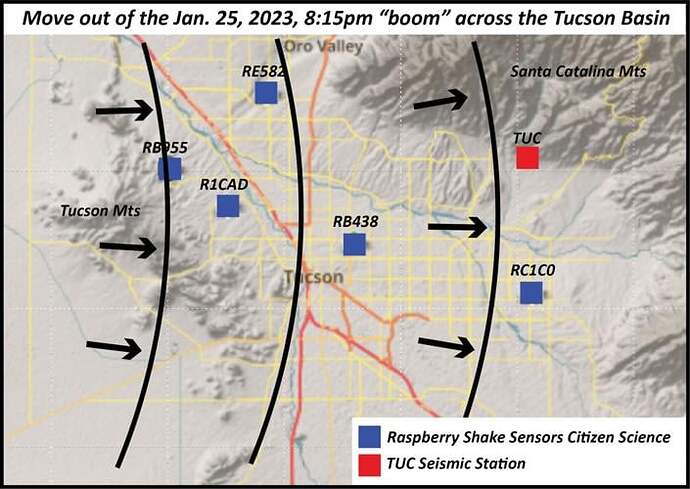Tucson AZ has periodically been on the receiving end of loud mystery sounds for years. I’ll admit one of the reasons I got an RBOOM myself was to get some data and timestamps on them. Early this year there were several days in a row of these sounds, and with a handful of infrasound stations around town now we can at least begin to determine direction and with seismic data too, pretty much determine they are atmospheric in origin. Some UofA geoscientists made the news with their analysis, which taps into the data from nearby raspberryshake instruments
Its likely paywalled but the relevant bits-
Two “mystery booms” rolled into Tucson from the west last month, rattling windows and triggering local seismic equipment in a way that suggests disturbances in the sky, not underground, according to a new analysis by geoscientists at the University of Arizona.
Seismologist Susan Beck and her colleagues compared data collected by Tucson’s main seismic station near Sabino Canyon to readings captured by a growing network of backyard sensors to determine the speed and direction of booms reported on Jan. 10 and 25.
What they found was the clear signature of an atmospheric disturbance moving from west to east at roughly the speed of sound.
The findings bolster the case that sonic booms — almost certainly from military aircraft — are responsible for the occasional house-shaking rumbles that Tucson residents have been experiencing for years.
“I’m sure it’s not an earthquake. I think we can rule that out,” said Beck, a professor in the UA’s Department of Geosciences. “I think the cause is in the air, and based on eliminating other sources, it’s probably planes.”
The path of the two booms last month — one at approximately 10:08 a.m. Jan. 10, the other at 8:15 p.m. Jan. 25 — suggest they came from the direction of the Barry M. Goldwater Range, the 1.9-million-acre military training ground in southwestern Arizona that stretches across parts of Pima, Maricopa and Yuma Counties.
The plots from six different local seismographs show the signal from a boom that was reported in Tucson on Jan. 10.
A map shows the movement of vibrations from a boom that was picked up by seismographs in Tucson on Jan. 10.
The plots from six different local seismographs show the signal from a boom that was reported in Tucson on Jan. 25.
A map shows the movement of vibrations from a boom that was picked up by seismographs in Tucson on Jan. 25.The recent UA analysis by was made possible by a Panama-based company called Raspberry Shake and its new line of affordable seismographs for at-home earthquake enthusiasts.
“That didn’t exist more than a few years ago,” Beck said. Five Raspberry Shake devices are now in operation around Tucson, all of them installed within the past two years. Without the publicly available data from those citizen-science instruments, Beck said she and her team would not have been able to determine the direction and speed of the two booms from last month.
Tucson has a rich history in the world of seismology. According to Beck, the official seismic station here — hosted by the UA and operated by the U.S. Geological Survey — dates back to the 1920s, making it one of the oldest in the nation.



